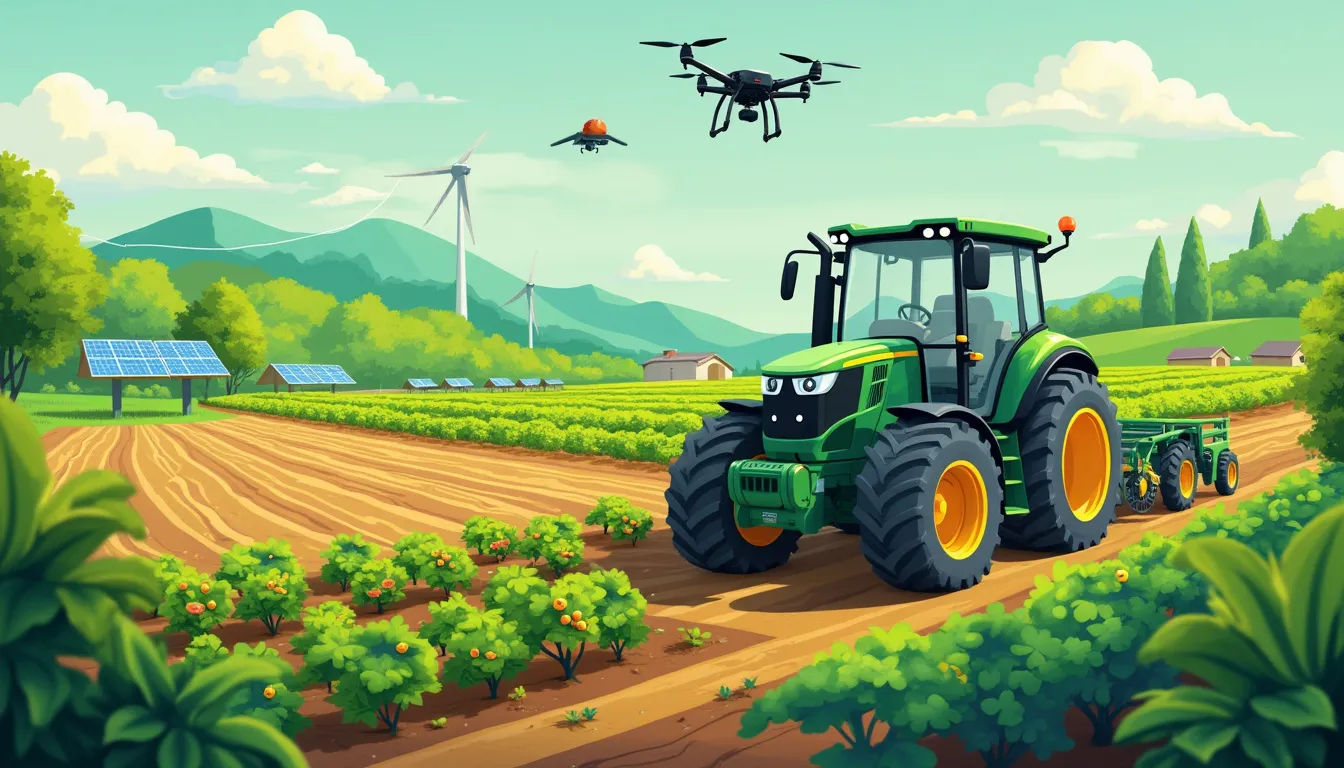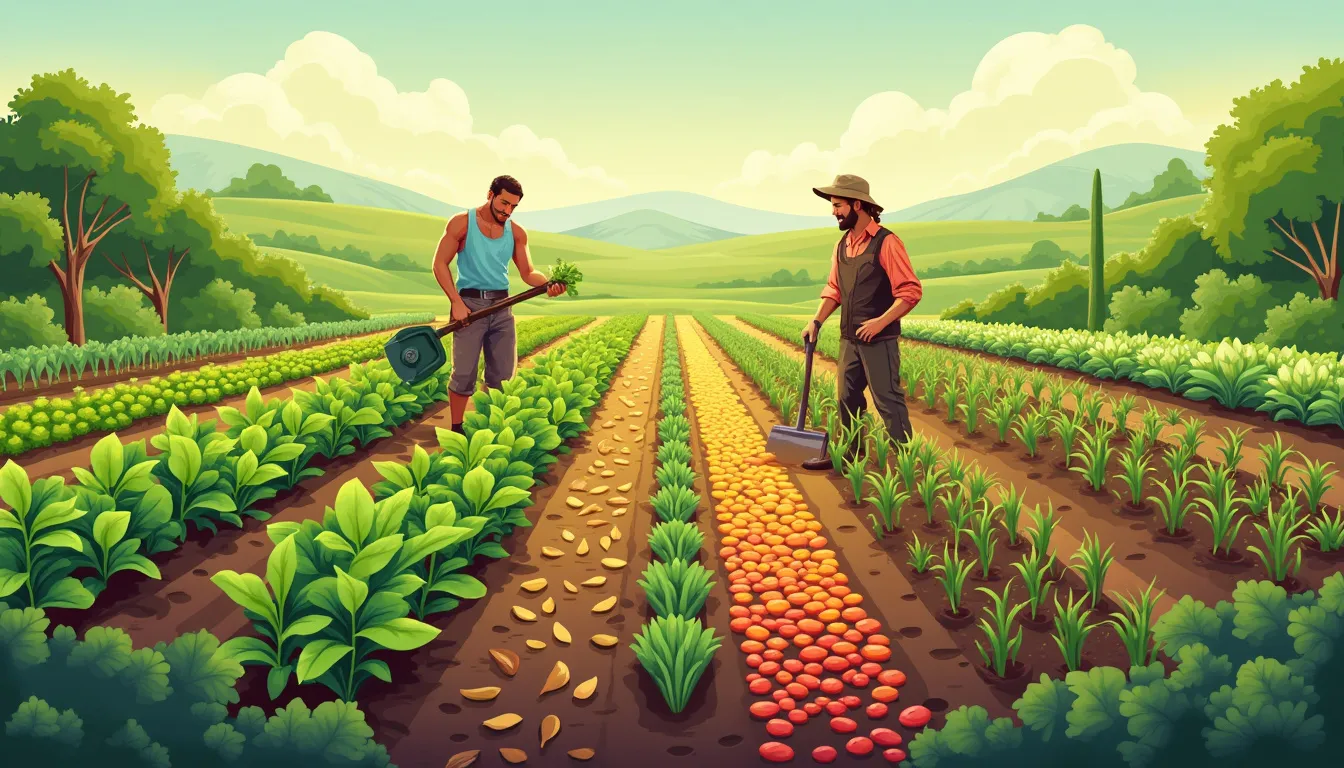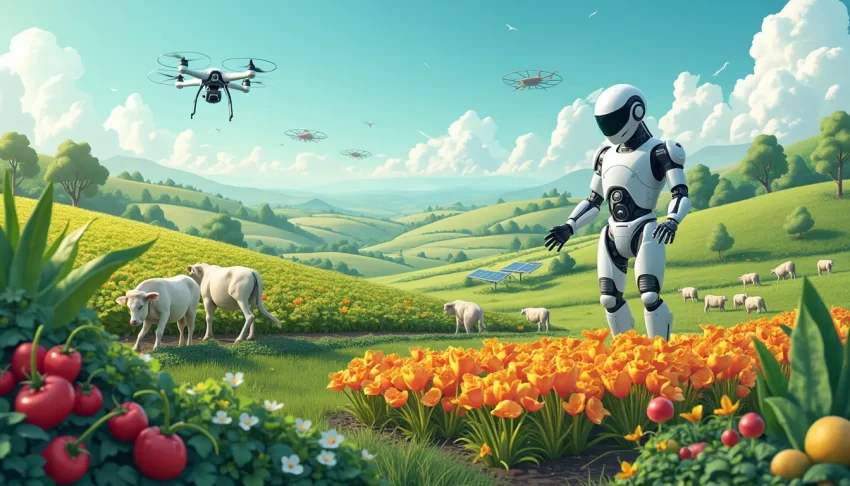Imagine a world where our food system is both productive and gentle on the earth, a world where the methods we use to grow what nourishes us also preserve and enrich the environment for future generations. This is not a distant dream but a burgeoning reality powered by sustainable agriculture. In essence, sustainable agriculture is an approach to farming that balances the need for food production with the necessity of maintaining ecological harmony. It has become increasingly vital as traditional farming practices face mounting challenges such as soil degradation, water scarcity, and the adverse effects of climate change.
Sustainability in agriculture isn’t just about avoiding harm; it’s about creating positive regenerative impacts. Despite the proven benefits, transitioning to sustainable methods can be daunting. Conventional farming practices have become deeply ingrained due to their short-term efficiency and profitability. However, their long-term consequences are becoming too severe to ignore, pushing the agricultural world to innovate and evolve.
In this article, we will explore the cutting-edge technologies and innovative practices redefining sustainable agriculture. We’ll dive into how precision farming is optimizing resource use, how biotechnology enhances crop resilience, and the role renewable energy plays in the fields. Additionally, we’ll look at sustainable practices that increase agricultural productivity, such as crop rotation, polyculture, and soil health management. The global movement towards sustainable farming will also be highlighted through key international policies and inspiring case studies. Finally, we’ll glimpse into future trends that hold the promise of a more sustainable and secure food future. Whether you’re a farmer wanting to make more environmentally friendly choices or a business owner looking to support sustainable practices, this comprehensive guide aims to inform, inspire, and equip you with the knowledge to embrace the future of sustainable agriculture.
Introduction to Sustainable Agriculture
Definition and Importance of Sustainable Agriculture
Sustainable agriculture is more than a buzzword; it’s a necessary shift in how we produce food to ensure long-term ecological balance and food security. At its core, sustainable agriculture aims to meet our current food and textile needs without compromising the ability of future generations to meet their own. This involves practices that enhance environmental health, economic profitability, and social and economic equity.
Why is this important? Consider the mounting evidence that our traditional agricultural practices are depleting resources, contributing to climate change, and endangering biodiversity. According to the Food and Agriculture Organization (FAO), agriculture is responsible for up to 29% of global greenhouse gas emissions. Practices like monocropping deplete soil nutrients and can lead to increased pest infestations, requiring more chemical interventions. Sustainable agriculture seeks to turn the tide by embracing practices that rejuvenate the land and mitigate harmful environmental impacts.
Current Challenges in Traditional Farming Practices
For centuries, conventional farming has focused on maximizing yield through artificial means—chemical fertilizers, pesticides, and large-scale monoculture farming. While these practices have indeed increased production, they’ve also led to severe downsides such as soil degradation, water scarcity, and biodiversity loss. Here are some of the most pressing challenges:
1. **Soil Degradation**: Continuous monocropping and excessive use of chemical fertilizers deplete crucial soil nutrients. FAO reports that we lose 24 billion tons of fertile soil annually due to unsustainable farming practices.
2. **Water Scarcity**: Agriculture consumes about 70% of the world’s freshwater resources. Inefficient irrigation and the overreliance on freshwater sources have led to the depletion of aquifers and rivers, putting long-term water availability at risk.
3. **Pesticide Resistance**: Heavy reliance on chemical pesticides has led to an increase in pesticide-resistant pests. This not only makes pest control more difficult but also necessitates the use of more potent and potentially harmful chemicals.
4. **Climate Change**: Agriculture both contributes to and is affected by climate change. Greenhouse gas emissions from farming activities exacerbate global warming, while changing weather patterns affect crop yields and farming reliability.
These challenges underscore the urgent need for sustainable agriculture, which could revolutionize the way we approach food production by shifting our focus from short-term gains to long-term viability.
Overview of the Article’s Focus on Innovations and Emerging Practices
In this article, we will delve into the exciting world of sustainable agriculture innovations and practices that promise to address these critical challenges. We will explore the technologies reshaping the agricultural landscape, such as precision farming, biotechnology, and renewable energy integration. Additionally, we will highlight the sustainable practices that enhance productivity while preserving natural resources, like crop rotation, polyculture, and regenerative farming techniques.
Each section will provide practical insights and real-world examples, aimed at inspiring both individuals and businesses to adopt more sustainable methods in their agricultural practices. By understanding the innovations and the practices that are leading the way, we can all do our part to contribute to a more sustainable and secure future for agriculture.
Stay tuned as we uncover how the fusion of traditional wisdom and modern technology is paving the way for a greener, more resilient agricultural system!

Technological Innovations Driving Sustainable Agriculture
Precision Farming and Its Impact on Resource Efficiency
Precision farming, also referred to as precision agriculture, utilizes data-driven technologies to optimize field-level management concerning crop farming. This practice leverages GPS mapping, IoT devices (Internet of Things), and advanced analytics to monitor and manage agricultural lands more effectively. By collecting real-time data on crop health, soil conditions, and weather patterns, farmers can make informed decisions that significantly enhance resource efficiency.
For instance, precision farming reduces the overuse of fertilizers and pesticides, which not only saves money but also minimizes environmental runoff that can pollute water bodies. Additionally, targeted irrigation systems improve water use efficiency by delivering the right amount of water directly to the plants’ roots, reducing wastage. John Deere’s suite of precision agriculture tools, such as the Field Connect and Machine Sync, exemplify how technology can help farmers achieve higher yields while reducing their ecological footprint.
Role of Biotechnology in Crop Resilience and Yield
Biotechnology is another frontier in sustainable agriculture, focusing on developing crops that are more resilient to climatic stresses, pests, and diseases. Through genetic modification and advanced breeding techniques, scientists can produce crop varieties that thrive in adverse conditions, thereby securing food supplies in the face of climate change. An example worth noting is BT cotton, which has been genetically engineered to be resistant to specific pests, thereby reducing the need for chemical pesticides.
Beyond pest resistance, biotechnology also encompasses the development of drought-tolerant crops and plants with enhanced nutritional profiles. The International Rice Research Institute (IRRI) has developed several types of drought-tolerant rice, which are now being grown successfully in areas that are prone to water scarcity. This not only ensures a stable food supply but also promotes the sustainable use of limited water resources.
Use of Renewable Energy Sources in Agriculture
Renewable energy plays a critical role in the drive towards sustainable agriculture, particularly in reducing the carbon footprint associated with farming activities. Solar panels, wind turbines, and bioenergy setups are increasingly being integrated into farming operations to provide clean and sustainable power sources.
Solar energy, for example, is being applied to power irrigation systems, grain drying processes, and even electrifying rural areas that are off the grid. The use of wind turbines on farms provides an additional revenue stream for farmers while contributing to the grid’s clean energy supply. In biodiesel production, agricultural waste and by-products are being converted into renewable energy, thus closing the loop in the agricultural ecosystem and minimizing waste.
A notable case is the use of anaerobic digesters in livestock farming, which converts manure into biogas that can be used for heating, electricity, and even fueling farm machinery. This not only cuts down on energy costs but also significantly reduces methane emissions—a potent greenhouse gas. Companies like Agri-Tech Producers, LLC, are pioneering these technologies, showcasing how renewable energy can be seamlessly integrated into sustainable farming practices.
Through these technological innovations, sustainable agriculture becomes not only a viable option but a compelling necessity. Precision farming, biotechnology, and renewable energy sources together create a holistic approach that addresses both productivity and sustainability. As these technologies advance and become more accessible, they hold the promise of transforming agriculture into a more efficient, resilient, and eco-friendly industry.

Sustainable Practices Enhancing Agricultural Productivity
Implementation of Crop Rotation and Polyculture
Crop rotation and polyculture are age-old practices that have gained renewed attention for their sustainable benefits. Crop rotation involves growing different types of crops in successive seasons on the same plot of land. This practice disrupts pest and disease cycles while improving soil fertility. For instance, rotating nitrogen-fixing legumes with nutrient-demanding crops like corn can naturally replenish soil nutrients, reducing the need for chemical fertilizers.
Polyculture, on the other hand, is the simultaneous cultivation of multiple crops in the same space. This practice mimics natural ecosystems, promoting biodiversity and resilience against pests and diseases. Such diversity minimizes the risk of total crop failure and can lead to more stable yields. For example, the Three Sisters farming method, used by Indigenous peoples in North America, combines corn, beans, and squash. Corn provides a structure for beans to climb, beans enrich the soil with nitrogen, and squash covers the ground to reduce weeds.
By adopting these sustainable practices, farmers can enhance productivity while preserving the environment. A study conducted by the Rodale Institute found that yield over a typical five-year rotation of corn-soybean-wheat-clover/alfalfa-hay was comparable to conventional methods but with 40% fewer inputs like chemical fertilizers.
Importance of Soil Health and Regenerative Farming Techniques
Soil health is the backbone of sustainable agriculture. Healthy soil not only supports crop growth but also plays a key role in carbon sequestration, water filtration, and ecosystem balance. Regenerative farming techniques focus on restoring and maintaining soil health through practices that mimic natural processes.
One such technique is the use of cover crops, which are grown not for harvest, but to cover the soil during off-seasons. Cover crops like clover, radishes, and rye prevent soil erosion, enhance soil structure, and boost organic matter. Research shows that fields with cover crops can reduce soil erosion by more than 50% compared to bare fields.
Another regenerative practice is minimal tilling, which reduces soil disturbance. Conventional tilling can break down soil structure and reduce its ability to retain water and nutrients. By minimizing tilling, farmers protect soil microorganisms and improve soil health. A 10-year study from the University of Illinois showed that no-till fields had 30% higher organic carbon content than tilled fields.
Additionally, composting organic waste into nutrient-rich humus can boost soil fertility and reduce the need for synthetic inputs. Innovative farmers are also utilizing “biochar”, a form of charcoal that improves soil health and carbon sequestration. Findings from Ithaka Institute indicate that biochar-amended soils can enhance crop yields by up to 20% depending on local conditions.
Water Management Practices for Sustainable Irrigation
Water is a critical resource in agriculture, and sustainable water management is essential for conserving this precious commodity. Efficient irrigation techniques not only reduce water usage but also improve crop yields and save energy.
Drip irrigation is a prime example of a water-efficient system. By delivering water directly to the plant roots, drip irrigation minimizes evaporation and runoff. According to the Food and Agriculture Organization (FAO), drip irrigation can achieve water use efficiency as high as 90%, compared to 60-70% for traditional sprinkler systems.
Rainwater harvesting is another sustainable practice that addresses water scarcity. By capturing and storing rainwater, farmers can reduce dependency on groundwater and surface water sources. Rainwater harvesting systems can be as simple as collecting water from rooftops into barrels or as complex as constructing large-scale catchment areas. In places like India, the practice has rejuvenated dry regions, showing water availability and crop yields increased by up to 30%.
Moreover, soil moisture sensors are being used to optimize irrigation schedules. These sensors provide real-time data on soil moisture levels, helping farmers to irrigate only when necessary. According to a study by the University of California, Davis, implementing moisture sensors along with precision irrigation strategies can reduce water use by up to 20% without compromising crop quality.
Innovative methods such as deficit irrigation, which involves applying water below full crop water requirements, are gaining traction. The technique encourages plants to become more drought-resistant and can be effective for certain crops like olives and grapes. A trial by the Instituto Valenciano de Investigaciones Agrarias in Spain showed that deficit irrigation reduced water use by up to 50% while maintaining 85-90% of grape yield, highlighting its potential in water-scarce regions.
In conclusion, sustainable practices like crop rotation, polyculture, regenerative farming, and efficient water management are revolutionizing agricultural productivity. These methods not only boost yields and resilience but also protect and enhance our natural resources. By embracing these practices, we pave the way for a more sustainable and secure food future.

The Global Movement Toward Sustainable Agriculture
Sustainable agriculture is not just a localized effort but a global necessity. As our planet faces increasingly severe climatic challenges, the collective steps taken by countries around the world are pivotal in shaping a resilient food system. This segment delves into the global movement towards sustainable agriculture, highlighting the critical international initiatives, successful case studies, and future trends that are set to redefine our approach to farming.
Key International Initiatives and Policies Supporting Sustainable Agriculture
Numerous international initiatives aim to promote sustainable agriculture, recognizing its importance for environmental health and food security. One prominent initiative is the United Nations’ Sustainable Development Goal (SDG) 2: Zero Hunger. This goal emphasizes the need to end hunger, achieve food security, improve nutrition, and promote sustainable agriculture by the year 2030. Under SDG 2, efforts are made to enhance agricultural productivity sustainably, ensure access to land, and ensure that food systems are resilient to climate change.
The Food and Agriculture Organization (FAO), another key player, has launched several programs such as the “Save and Grow” initiative, which advocates for a farming approach that preserves resources while enhancing productivity. Save and Grow focuses on integrating sustainable practices like conservation tillage, cover cropping, and agroforestry into traditional farming systems.
On a regional level, the European Union’s Common Agricultural Policy (CAP) has undergone significant reforms to integrate more sustainable practices. The latest CAP reforms encourage farmers to adopt green practices through financial incentives, prioritizing environmental care, climate action, and the preservation of biodiversity.
Case Studies of Successful Sustainable Farming Models
Real-world examples of sustainable agriculture showcase how these practices can be both profitable and environmentally friendly. One inspiring case is Van Leeuwen Dairy in California, USA. This dairy farm implemented a digester system that converts cow manure into renewable energy, significantly reducing methane emissions and providing a renewable energy source for the farm and surrounding community. As a result, Van Leeuwen Dairy has cut down on greenhouse gas emissions and created a circular economy model that serves as a template for other dairy farms.
In Kenya, the One Acre Fund has revolutionized smallholder farming by providing farmers with the tools, training, and financing they need to succeed. The organization’s holistic approach involves teaching farmers about crop diversification and soil health, thereby increasing resilience to pests and climate change. Participants have witnessed yields doubling and incomes stabilizing, proving that sustainable practices can drive economic empowerment.
Future Trends and the Potential Impact on Global Food Security
Sustainability in agriculture is continuously evolving, with emerging trends offering promising solutions for the future. One such trend is the adoption of vertical farming systems. These systems allow crops to be grown indoors in stacked layers, conserving water and land while enabling year-round production. Companies like AeroFarms are leading the charge, utilizing aeroponic technologies that reduce water usage by up to 95% compared to traditional farming.
Another promising development is the advancement in synthetic biology. Innovations in this field are enabling the creation of genetically engineered crops that are more resilient to climate change, pests, and diseases. These crops not only require fewer resources to grow but also help to secure food supplies in the face of a rapidly changing climate.
Moreover, the rise of digital farming platforms is empowering farmers with data-driven insights. These platforms, fueled by AI and machine learning, facilitate precision agriculture by providing real-time analysis of soil conditions, weather forecasts, and crop health. With this information, farmers can make informed decisions that optimize resource use and maximize yields sustainably.
The cumulative effect of these innovations and sustainable practices suggests a transformative future for global agriculture. By embracing these advancements, the agricultural community can hope to mitigate the risks associated with climate change, improve food security, and ensure a steady food supply for the growing global population.
Globally, the march towards sustainable agriculture is not only a movement but a necessity for the future. Through worldwide cooperation, innovations, and the commitment of farmers and policymakers alike, we can pave the way for a more secure and sustainable food system. Each initiative, each success story, and each forward-looking trend contributes a piece to the larger puzzle of global food security, highlighting the importance and potential of sustainable agriculture.
As we look ahead to the future of sustainable agriculture, it becomes evident that the synergy between innovative technologies and time-honored practices holds immense potential. Sustainable agriculture is not just a trendy buzzword; it is a critical strategy for ensuring food security, preserving natural resources, and fostering resilient agricultural communities.
The technological innovations discussed, from precision farming to biotechnology, highlight how modern tools can significantly enhance resource efficiency and crop resilience. Precision farming, for example, allows for the meticulous application of water, fertilizers, and pesticides, reducing waste and improving crop yields. Biotechnology advances continue to make crops more resistant to pests and climate extremes, essential in a world facing unprecedented environmental challenges. Moreover, the integration of renewable energy in farming operations not only reduces carbon footprints but also paves the way for a more sustainable and self-sufficient agricultural future.
Equally important are the sustainable practices that have been overlooked in the rush to maximize productivity through conventional means. Crop rotation and polyculture exemplify how diversifying planting schedules and species can naturally suppress pests, improve soil health, and boost yields without relying on harmful chemicals. Regenerative farming techniques underscore the importance of nurturing soil health, ensuring that this fundamental resource remains productive for generations to come. Effective water management practices, in turn, address one of agriculture’s most pressing needs—sustainable irrigation. Techniques such as drip irrigation and rainwater harvesting play crucial roles in conserving water, particularly in arid regions.
No discussion on sustainable agriculture would be complete without acknowledging the global movement supporting these practices. International policies and initiatives, case studies from pioneering farmers, and collaborative efforts paint a hopeful picture of what is possible. Programs and policies at the global level are vital in setting standards, providing funds, and fostering cooperation among nations. Case studies offer valuable lessons and inspiration, serving as blueprints for other regions looking to adopt similar approaches. Future trends in sustainable agriculture, such as urban farming and agroforestry, promise to further transform our food systems and strengthen global food security.
As individuals and business owners, we each have a role to play in this transformative journey. Simple actions, such as supporting local and sustainable food sources, reducing food waste, or advocating for sustainable policies, collectively make a significant impact. For business owners in the agricultural sector, investing in technologies and practices that promote sustainability not only benefits the environment but also ensures long-term profitability and resilience.
Ultimately, the future of sustainable agriculture depends on our collective will to innovate, adapt, and prioritize the health of our planet. By combining cutting-edge technologies with time-tested methods, we can create a sustainable and resilient agricultural system capable of feeding the world while preserving the earth for future generations. Let’s embrace this challenge with the knowledge that every small step towards sustainability brings us closer to a thriving future.
Support Us: Check out our recommended products on Amazon.

